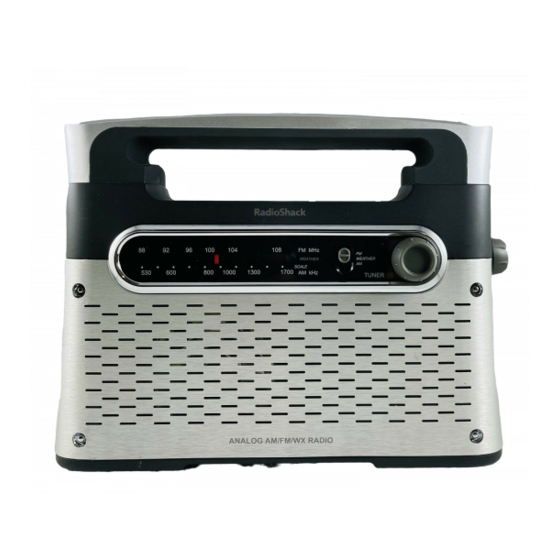
Advertisement
Quick Links
Analog AM/FM/WX Radio
Thank you for purchasing your AM/FM/WX AC/DC Portable Radio
from RadioShack.
retractable antenna
Fully extend for best FM/WX reception.
TUNER
Rotate to select radio station.
NOTE: The AM antenna is built
in. To improve AM reception,
rotate the radio.
ON/OFF/Volume
Rotate to turn on and adjust
volume.
ear phone jack
Band Switch
Swtich between AM, FM, and
weather report band.
NOTE: Actual product may vary from images found here.
Please read this user's guide before
installing, setting up, and using your new product
www.radioshack.com
12-889
Your RadioShack portable radio requires four C batteries (not supplied, available at RadioShack or online at
www.radioshack.com) or 120V AC power.
1. Remove the battery
compartment cover.
Replace when
finished.
2. Route the power cord
through the slot and
plug into standard
120V AC outlet. Or,
place batteries in
the compartment
as indicated by the
polarity symbols
(+ and -) marked inside.
caring for your radio
• Keep your radio dry. If it gets wet, wipe it dry
immediately.
• Use and store your radio only in room
temperature environments.
• Handle the radio carefully. Do not drop it.
• Keep your radio away from dust and dirt, and
wipe it with a damp cloth occasionally to keep it
looking new.
• Modifying or tampering with your radio's
internal components can cause a malfunction
and might void your FCC authorization to
operate it.
what's included
Portable Radio
powering your radio
battery notes
• Dispose of old batteries promptly and properly.
Do not burn or bury them.
power cord
• Use only fresh batteries of the required size and
recommended type.
batteries
• Do not mix old and new batteries or batteries of
different types, capacities, or chemistries.
battery
• If you do not plan to use your radio for a month
compartment
or longer, remove the batteries. Batteries can
leak chemicals that may destroy electronic parts.
• Keep batteries out of reach of children. They can
be fatal if swallowed.
CAUTION: This device is equipped with a polarized plug
to prevent electric shock. One blade is wider than the
other. The plug can only fit in an outlet one way. If you
cannot easily insert the plug, turn it over and try again.
Do not force it.
listening safely
To protect your hearing, follow these guidelines when
you use ear phones or head phones.
• Set the volume to the lowest setting before you
begin listening with your ear phones. After you begin
listening, set the volume to a comfortable level.
• Do not listen at extremely high volume levels.
Extended high-volume listening can lead to
permanent hearing loss.
• Once you set the volume do not increase it. Over
time, your ears adapt to the volume level, so a
volume level that does not cause discomfort might
still damage your hearing.
traffic safety
Do not wear ear phones or head phones while operating
User's Guide
a motor vehicle or riding a bicycle. This can create a
traffic hazard and could be illegal in some areas.
Even though some earphones or headphones let you
hear some outside sounds when listening at normal
volume levels, they can still present a traffic hazard.
using your radio
Advertisement

Summary of Contents for Radio Shack 12-889
-
Page 1: Powering Your Radio
12-889 Your RadioShack portable radio requires four C batteries (not supplied, available at RadioShack or online at www.radioshack.com) or 120V AC power. Analog AM/FM/WX Radio battery notes 1. Remove the battery compartment cover. • Dispose of old batteries promptly and properly. Thank you for purchasing your AM/FM/WX AC/DC Portable Radio Replace when from RadioShack. -
Page 2: Important Safety Instructions
National Electrical Code, ANSI/NFPA 70, provides information with regard to proper grounding of the mast and supporting structure, grounding of the mast and supporting structure, Model 12-889 grounding of the lead-in wire to an antenna-discharge unit, size of grounding conductors, location of antenna-discharge unit, connection to grounding electrodes, and requirements for the grounding electrode.










